TIPWelcome to my CS205 lecture notes! Because the lecture is not in English, I will try my best to translate it.
And at the same time, the
PPT,lab-filealso use the English,I will write the English notes but not all.
NOTEIf you have a passion to konw more about the course, you can click the link below to learn more about the course. Read the repo.
Waiting for api.github.com...
WARNING由于本文篇幅过长,个人会添加适当的中文注解在里面。
Introduction:
In this note, you will learn about that:
Commands in Linux
commands: directory, file .etc.
lists of commands, pipelines
Makefile
file: makefile/Makefile
command: make, make clean
Practices
commands, makefile
branch, loop
Commandas in Linux
Linux is a family of open-source Unix operating systems based on the Linux Kernel.
There are some popular distributions such as Ubuntu, Fedora, Debian, openSUSE, and Red Hat.
A Linux command is a program or utility that runs on the Command Line Interface – a console that interacts with the system via texts and processes.
Linux command’s general syntax looks like:
CommandName [option(s)] [parameter(s)]- CommandName is the rule that you want to perform.
- Option or flag modifies a command’s operation. To invoke it, use hyphens (-) or double hyphens (—).
- Parameter or argument specifies any necessary information for the command.
1.1 Linux directory and file commands:
| Command | Meaning |
|---|---|
| pwd | Print the name of current/working directory. |
cd <directory name> | Change the current directory. |
| ls | List of content of a directory. |
mkdir <directory name> | Make a new directory under any directory. |
rmdir <directory name> | Remove directories without files. |
cat <file name> | Display content of the file. |
rm <file name> | Remove a file. |
cp <source> <dest> | Copy a file or files to another |
mv <source><dest> | Move a file or files to another directory |
cat/tail/head, less/more, nano/vim, file, whereis, echo
You can click here to visit the commands of Linux/Ubuntu
1.1.1 Absolute path and relative path
A path is how you refer to files and directories. It gives the location of a file or directory in the Linux directory structure. It is composed of a name and slash syntax.
If the path starts with slash ”/”, the first slash denotes root. The rest of the slashes in the path are just separators.
用\虽然说在md格式下是可行的,但是还是不符合Astro框架下的文件引用,因为这件事我很多次博客部署失败…
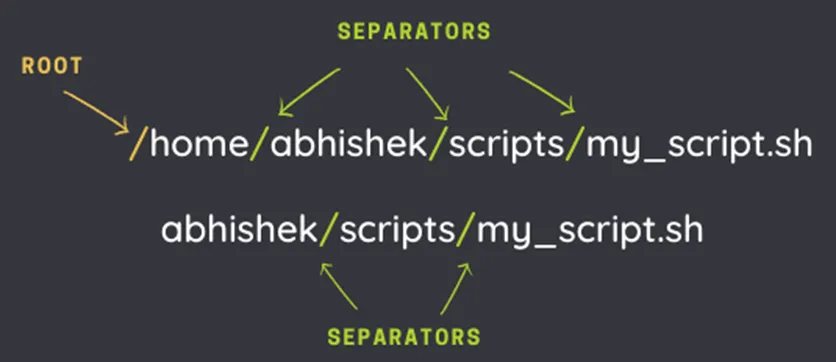
The one is aboslute path,because it include /root/ directory(In Linux it means start).
A relative path starts from the current directory.
NOTETwo special relative paths:
. ( single dot) denotes the current directory in the path.
.. (two dots) denotes the parent directory, i.e., one level above.
1.1.2 pwd command
Use the pwd command to display the current working directory you are in.
Start Ubuntu, you will see:
![]()
$ or # is the prompt, you can type command now.

/mnt/d/manage means the current directory.
1.1.3 cd command
To navigate through the Linux files and directories, use the cd command.

you can use the below command to open the directory:
cd /mnt/dIt means you use the absolute path to open the directory,change the directory to the root directory of d drive
![]()
cd /root/change the directory to the root directory,root means the adminitor files,the home means the ordinary users’ files.
TIProot和home,前者为管理员用户的个人文件,后者为普通用户的个人文件,权限不同,由于这里用的是wsl连接,获得到的是最高级权限。

cd /change the directory to the root directory.

cd ~change the directory to the home directory
You can see that : There’s a go files in my home directory,because I have installed the go enviornment.
But actually you see that: There’re so many folders in root directory.
Here are some shortcuts to help you navigate:
- cd ~[username] goes to another user’s home directory.
- cd .. moves one directory up.
- cd - moves to your previous directory.
- cd without an option will take you to the home folder.
1.1.4 ls command
The ls command lists files and directories within a system. Running it without a flag or parameter will show the current working directory’s content.
And you see I used it in cd command.

You can see ls:

Here are some options you can use with the ls command:
- ls -R lists all the files in the subdirectories.
- ls -a shows hidden files in addition to the visible ones.
- ls -l (or ll) shows detail information of subdirectory and files
1.1.5 mkdir command
Use the mkdir command to create one or multiple directories at once.

NOTEAplogize to you, I use the original picture.
1.1.6 rmdir command
Use the rmdir command to permanently delete an empty directory.

1.1.7 rm command
The rm command is used to delete files within a directory. Make sure that the user performing this command has write permissions.

rm test.txt helloMeans thattest.txt,and hello,DONOT require you confirmation.
Here are some acceptable options you can add:
- -i prompts system confirmation before deleting a file.
- -f allows the system to remove without a confirmation.
- -r deletes files and directories recursively.
1.1.8 cp command and mv command
The cp command is used to copy a file or directory.

cp main.cpp testThe mv command is used to move a file or a directory form one location to another location.


mv A Bmeans that
mv A B Cmenas that: Moving A into B and Renaming its name
1.1.9 cat command
Concatenate, or cat, is one of the most frequently used Linux commands. It lists, combines, and writes file content to the standard output. To run the cat command, type cat followed by the file name and its extension.
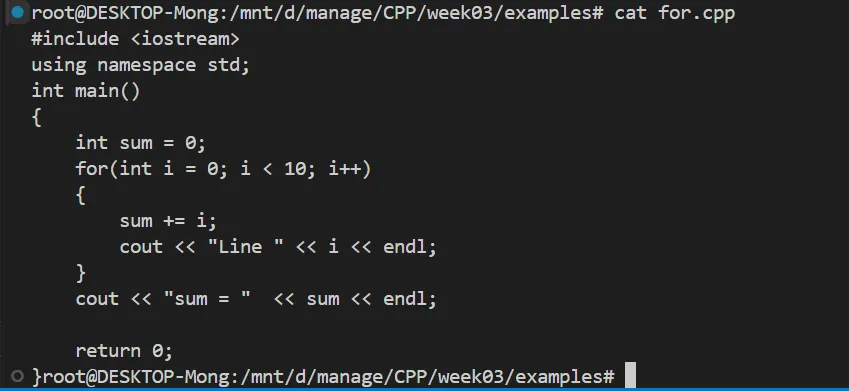
Here are other ways to use the cat command:
- cat > filename.txt creates a new file.
- cat filename1.txt filename2.txt > filename3.txt merges filename1.txt and filename2.txt and stores the output in filename3.txt.
- tac filename.txt displays content in reverse order.
1.2 lists of commands, pipelines
1.2.1 lists of commands
An AND list has the form: command1
&&command2- command2 is executed if, and only if, command1 returns an exit status of zero (success).
An OR list has the form: command1
||command2- command2 is executed if, and only if, command1 returns a non-zero exit status.
Command Sequence: command1
;command2
- Commands separated by a ‘
;’ are executed sequentially;
TIPFor the shell’s purposes, a command which exits with a zero exit status has succeeded. A non-zero exit status indicates failure.
The exit status of the last command is available in the special parameter $?

1.2.2 pipelines
- A pipeline is a sequence of one or more commands separated by one of the control operators
|or|&. - The output of each command in the pipeline is connected via a pipe to the input of the next command. That is, each command reads the previous command’s output. This connection is performed before any redirections specified by command1.
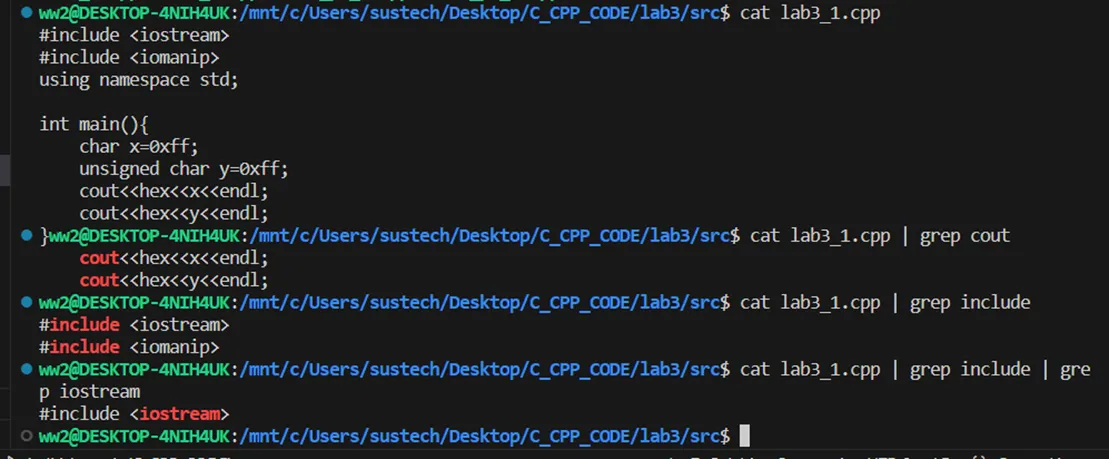

TIPS: Shortcut keys
Upand down arrow keys can list the commands you typed.Tabkey can complete the command. For a long command, you can type first few letters and press Tab key to complete the command or list alternate commands.

clear is a standard Unix computer operating system command that is used to clear the terminal screen.
![]()
gcc & g++
gcc and g++ are GNU C or C++ compilers respectively, which issued for preprocessing,
compilation, assembly and linking of source code to generate an executable file.
Type command gcc or g++ —help, you can get the common options of the gcc or g++. g++ accepts
mostly the same options as gcc.
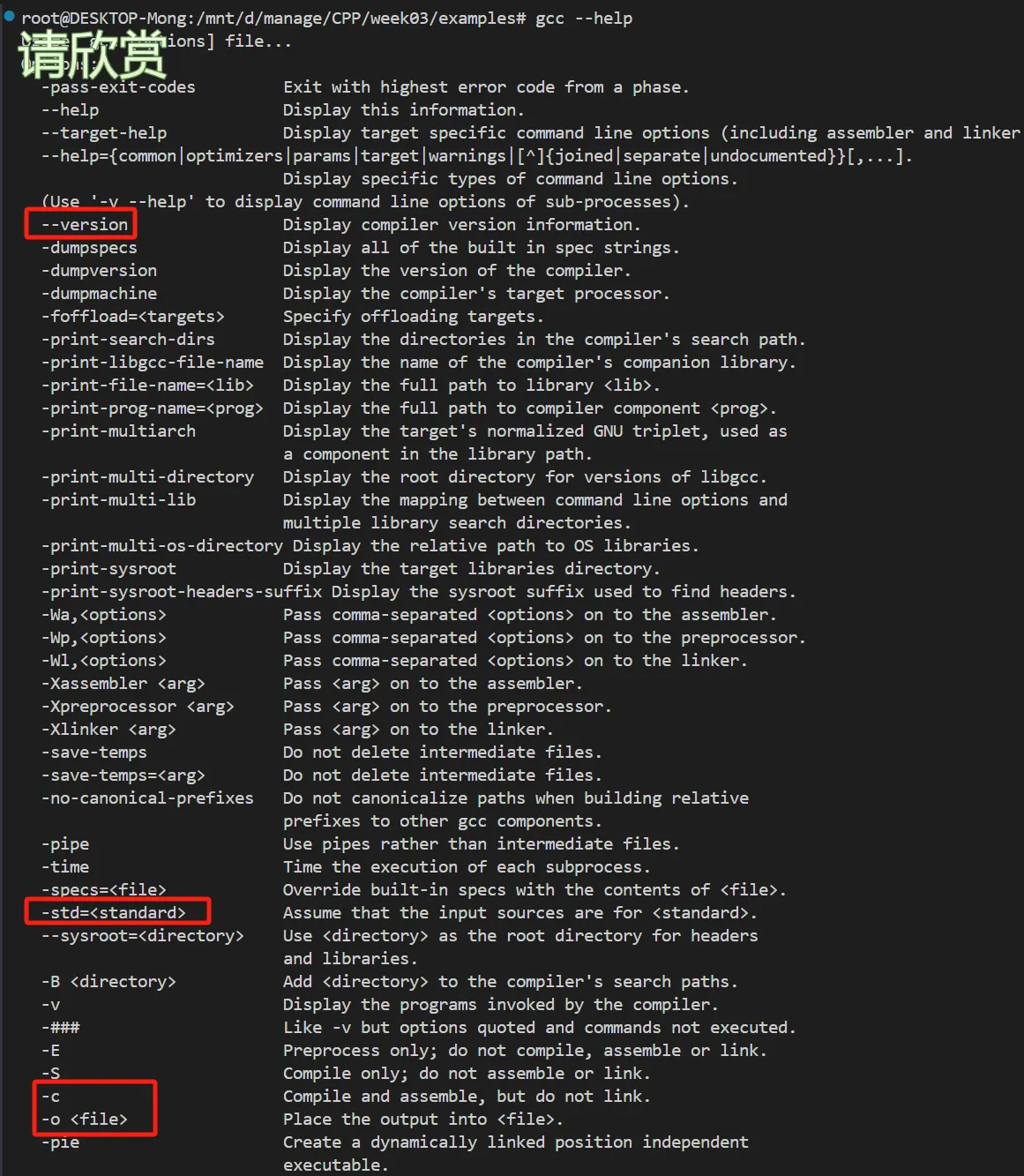
-c Compile or assemble the source files, but do not link. The ultimate output is in the form of an object file for each source file. The object file name for a source file is made by replacing the suffix .c with .o.
-o
whether it be an executable file, an object file, an assembler file or preprocessed C code.
If -o is not specified, the default is to put an executable file in a.out.
we use gcc source_file.c -o program_name or gcc source_file.o -o program_name to compile the c&cpp files.

With one step to generate an executable target file:
gcc file_name or g++ file_name
This command is used to compile and create an executable file a.out (default target name).
#include <iostream>
using namespace std;
int main()
{
cout << "Hello World!!!" << endl;
return 0;
}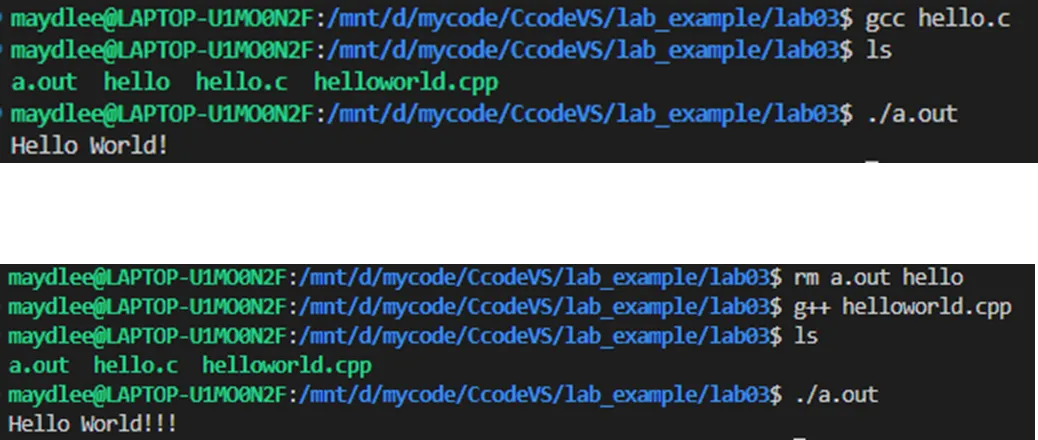
2.1 compile multiple files
You can compile the files one by one and then link them to an executable file.
Another choice is using one step to list all the .c(or .cpp) files after gcc(or g++) command and create an executable file named a.out.
//area.h
#define PI 3.1415
double compute_area(double r);
//area.c
#include "area.h"
double compute_area(double r)
{
return PI * r * r;
}
//main.c
#include <stdio.h>
#include "area.h"
int main()
{
double r, area;
printf("Please input a radius:");
scanf("%lf", &r);
area = compute_area(r);
printf("The area of %lf is %.4lf\n", r, area);
return 0;
}

Makefile
What is a Makefile?
Makefile is a tool to simplify and organize compilation. Makefile is a set of commands with variable names and targets . You can compile your project(program) or only compile the update files in the project by using Makefile.
If you wanna know more Makefile click here.
And if you wanna know the example you can click here come to my github repo read this code.
Normally, you can compile these files by the following command:


How about if there are hundreds of files to compile? If only one source file is modified, need we compile all the files? Makefile will help you.
The name of makefile must be either makefile or Makefile without extension.You can write makefile in any text editor. A rule of makefile including three elements: targets, prerequisites and commands. There are many rules in the makefile.
A makefile consists of a set of rules. A rule including three elements: target,prerequisites and commands.
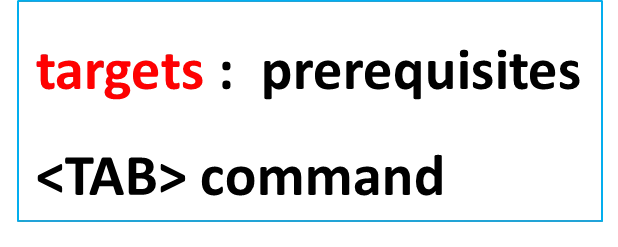
- The target is an object file, which is generated by a program. Typically, there is only one per rule.
- The prerequisites are file names, separated by spaces, as input to create the target.
- The commands are a series of steps that make carries out. These need to start with a tab character, not spaces.
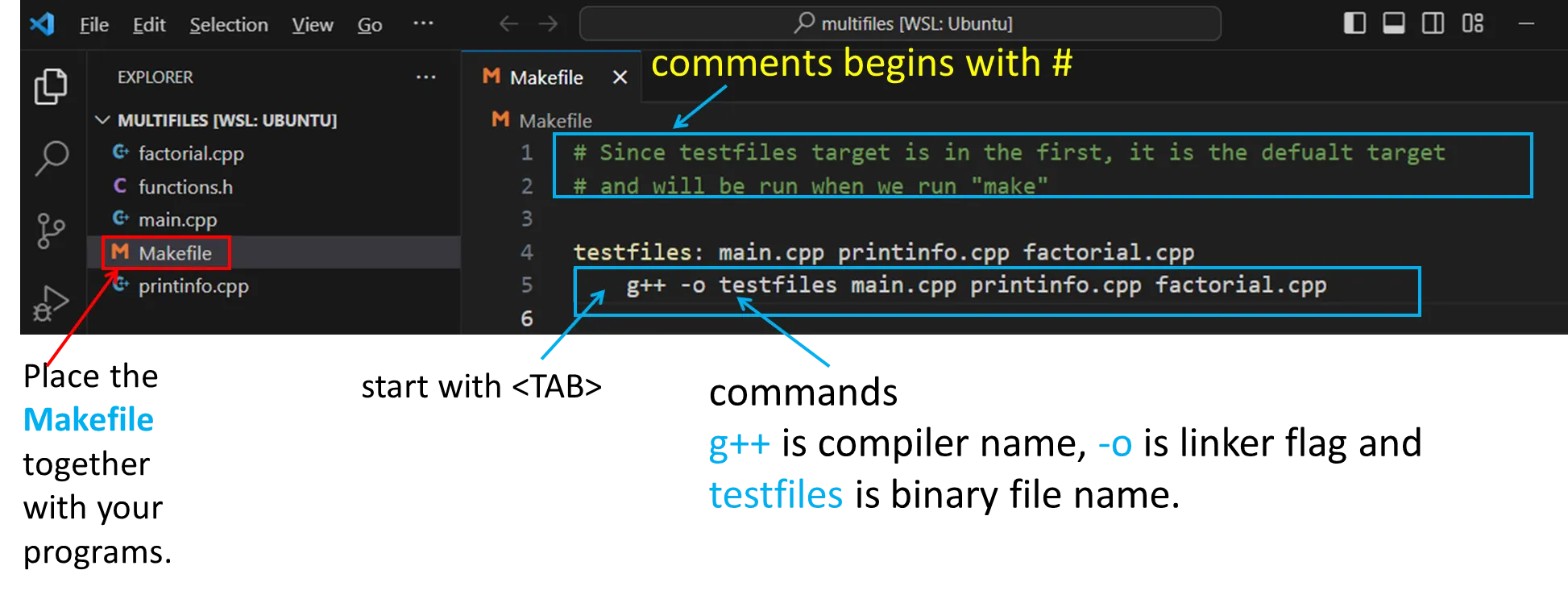
Type the command make in VScode
![]()
If you don’t install make in VScode, the information will display on the screen.
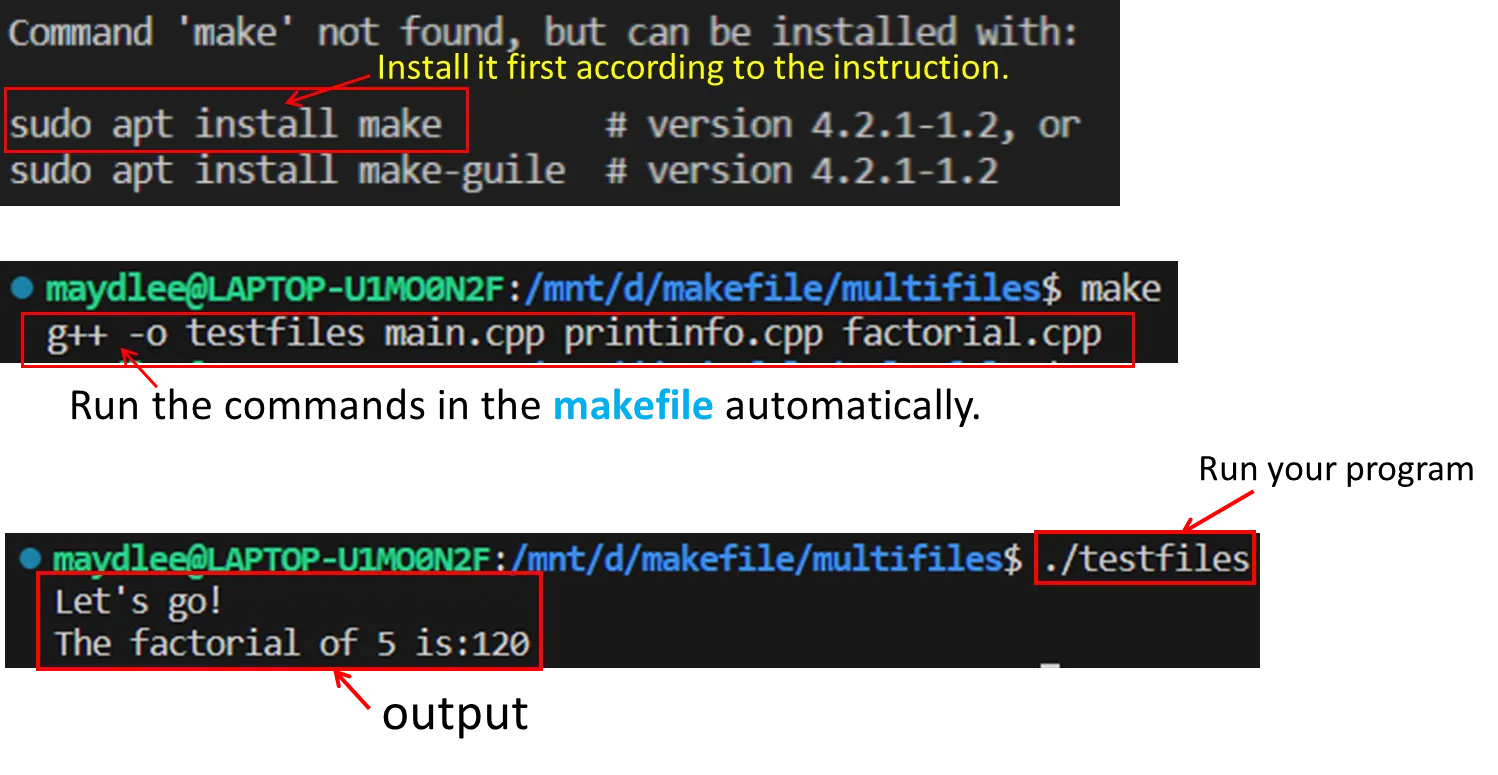
3.1 Define Macros/Variables in the makefile
To improve the efficiency of the makefile, we use variables.
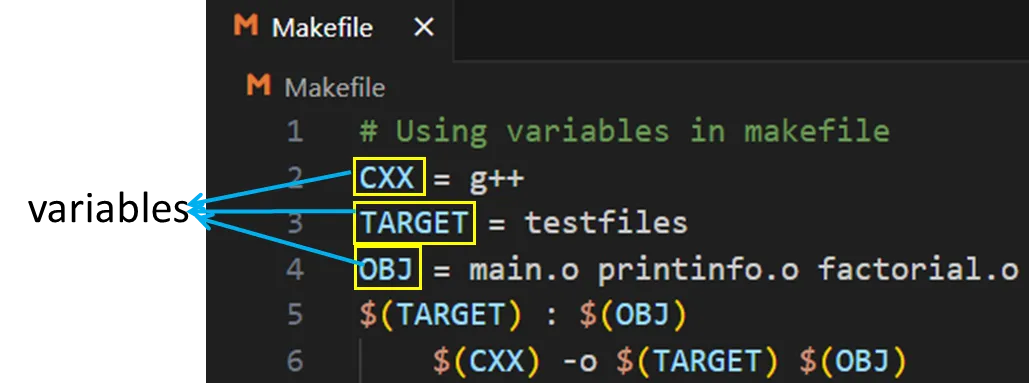
start with$()

NOTEDeletes all the .o files and executable file created previously before using make command. Otherwise, it’ll display:
If only one source file is modified, we need not compile all the files. So, let’s modify the makefile.
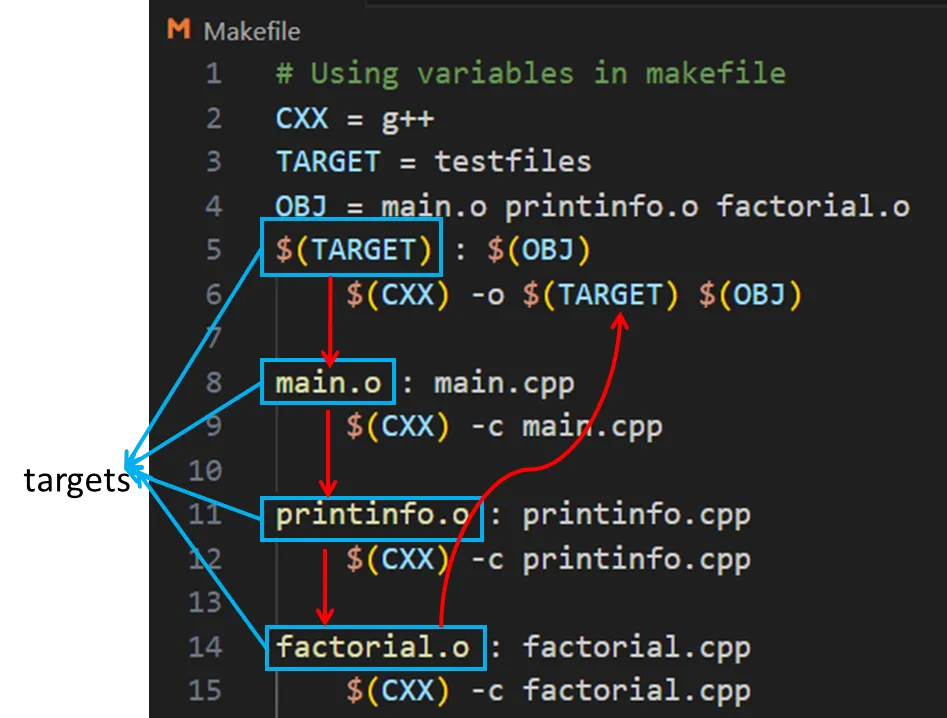
If main.cpp is modified, it is compiled by make.

All the .cpp files are compiled to the .o files, so we can modify the makefile like this:
# Using several ruls and several targes
CXX = g++
TARGET = testfiles
0BJ = main.o printinfo.o factorial.o
# options pass to the compilen
#-c generates the object file
# -Wall displays compiler warning
CFLAGS = -c -Wall
$(TARGET) : $(OBJ)
$(CXX) -o $@ $(OBJ)
%.o : %.cpp
$(CXX) $(CFLAGS) $^$@: the target file
$^: all the prerequisites files
$<: the first prerequisite file
%.o:%.cppor
$(CXX) $(CFLAGES)$^TIP实际上,就是说Makefile的存在很好的消除了我们的命令行输入输出需求。正所谓前人栽树后人乘凉的道理,由于VSCode本身不存在已经配置好的环境,我们还需要自己手动写一份Makefile文件【当然也可以用ai作为助手当作辅佐工具】,如果实在是头疼配置问题,可以移步到下载VS(Visual Studio)的下载,VSCode只是相当于一个轻文本编辑器,许多环境都是我们自行配置的,而VS相当于集成的IDE,只是所需内存更大。但是相对而言,VS的即装即用是很多学C/Cpp的新手首选。
3.2 Phony target
Using phony target to clean up compiled results automatically
# Using several rules and several targets
CXX = g++
TARGET = testfiles
OBJ = main.o printinfo.o factorial.o
# options pass to the compiler
# -c generates the object file
# -Wall displays compiler warning
CFLAGS = -c -Wall
$(TARGET) : $(OBJ)
$(CXX) -o $@ $(OBJ)
%.o : %.cpp
$(CXX) $(CFLAGS) $^
.PHONY : clean
clean:
rm -f *.o $(TARGET)Because clean is a label not a target, the command make clean can execute the clean part. Only make command can not execute clean part.
Adding .PHONY to a target will prevent making from confusing the phony target with a file name.
TIP这里实际上就是借用了PHONY来删除多余的编译文件
Functions in makefile

SRC=$(wildcard ./*.cpp)$
target:
@echo $(SRC)$
patsubst(pattern substitution): replace file
$(patsubst original pattern, target pattern, file list)

SRC = $(wildcard ./*.cpp)$
OBJ = $(pasubst %.cpp,%o,$(SRC))$
target:
@echo $(SRC)
@echo $(OBJ)
3.3 OBJS vs OBJ
OBJS=$(patsubst %.cpp,%.o,$(SRC))$Vs
OBJ=main.o printinfo.o factorial.o
TIP我们可以看到OBJS只需要描述法就可以使用了,比OBJ直接列举法要来得简单得多。但是利弊也是看情况,文件不多的情况下也可以酌情用OBJ。
3.4 Use Options to Control Optimization
-O1, the compiler tries to reduce code size and execution time, without performing any optimizations that take a great deal of compilation time.
-O2,Optimize even more. GCC performs nearly all supported optimizations that do not involve a space-speed tradeoff. As compared to -O1, this option increases both compilation time and the performance of the generated code.
-O3, Optimize yet more. O3 turns on all optimizations specified by -O2.
You can click here to learn more:
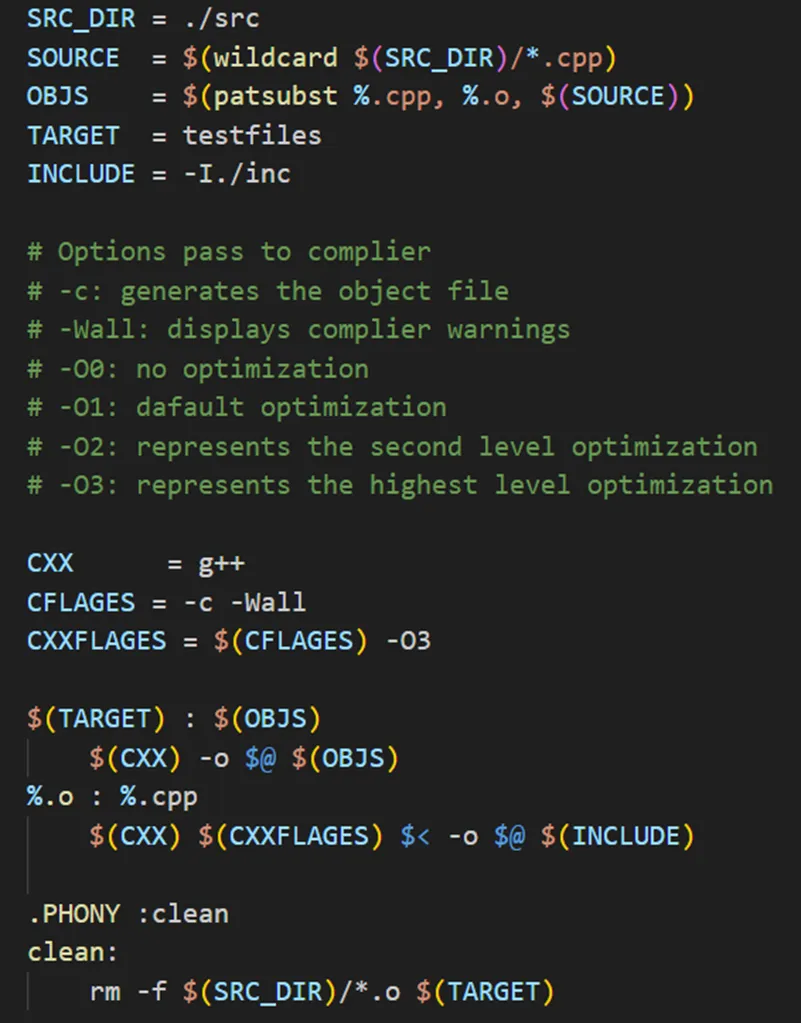
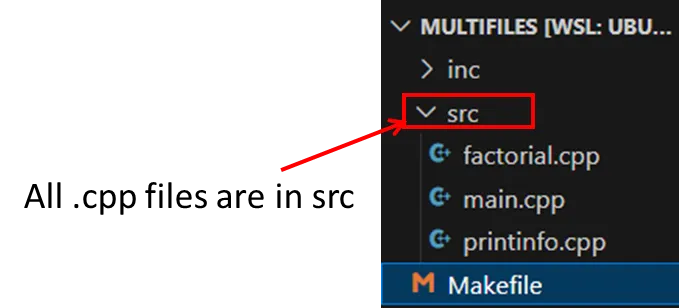

Exercise
4.1 Exercises . commands and command list
The existing directory structure is shown in the upper right image. There are different types of C/C++files in the p1 directory while the directory structure under p2 is unknown. 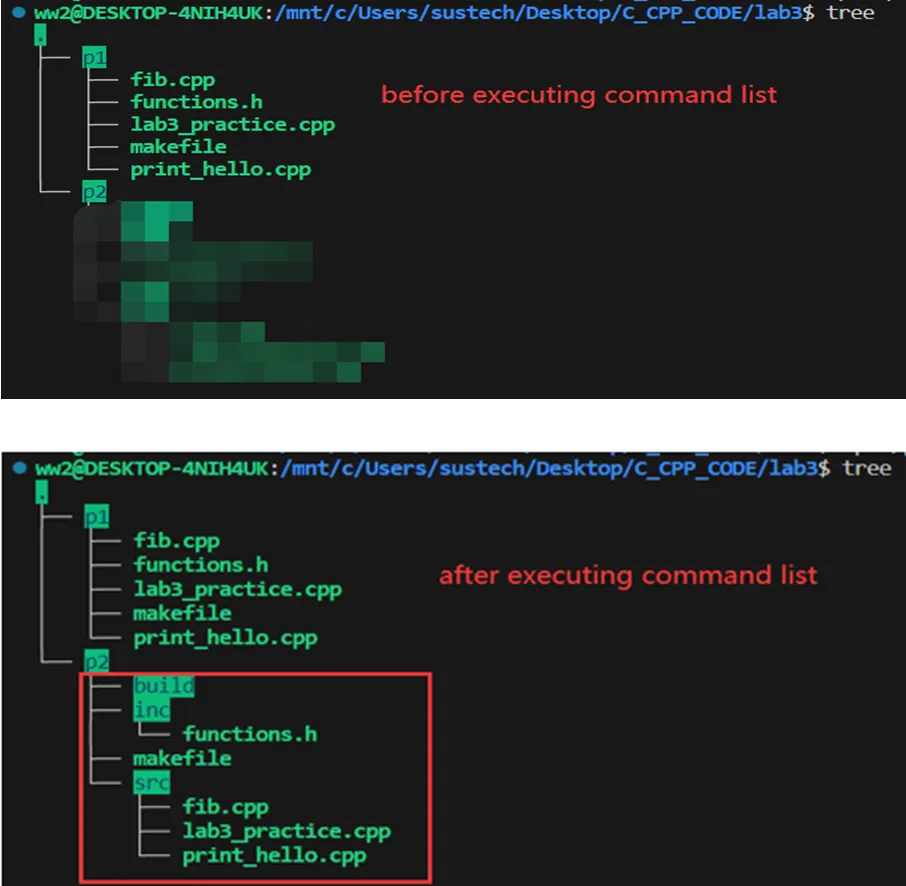
WARNINGTask. Use the command list to create subdirectories as needed and place files of different types into different subdirectories in the
p2directory (as shown in the lower right image).Place the header file inp2/inc, and the cpp source file inp2/src, and createp2/build.
NOTE
when using commands, if there is already an
incsubdirectories, do not createincrepeatly. If there is noincsubdirectories, create it;The same requirement also applies tosrcandbuild.File copying work should only be performed after the destination subdirectories have been created.
Use as few command lists as possible to complete this exercise (options include
and list,or list,command sequence, which can be combined as needed)
My implements:

or use this:
mkdir -p p2 &&
cd p2 &&
mkdir -p inc src build && \
cp -u ../lab/functions.h inc/ && \
cp -u ../lab/makefile inc/ && \
cp -u ../lab/factorial.cpp src/ && \
cp -u ../lab/main.cpp src/ && \
cp -u ../lab/printhello.cpp src/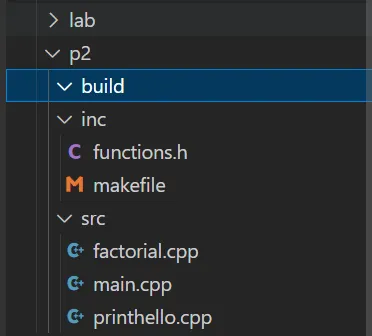
4.2 Exercises . Makefile and make
create a makefile, run it by command make or make clean to complete following tasks:
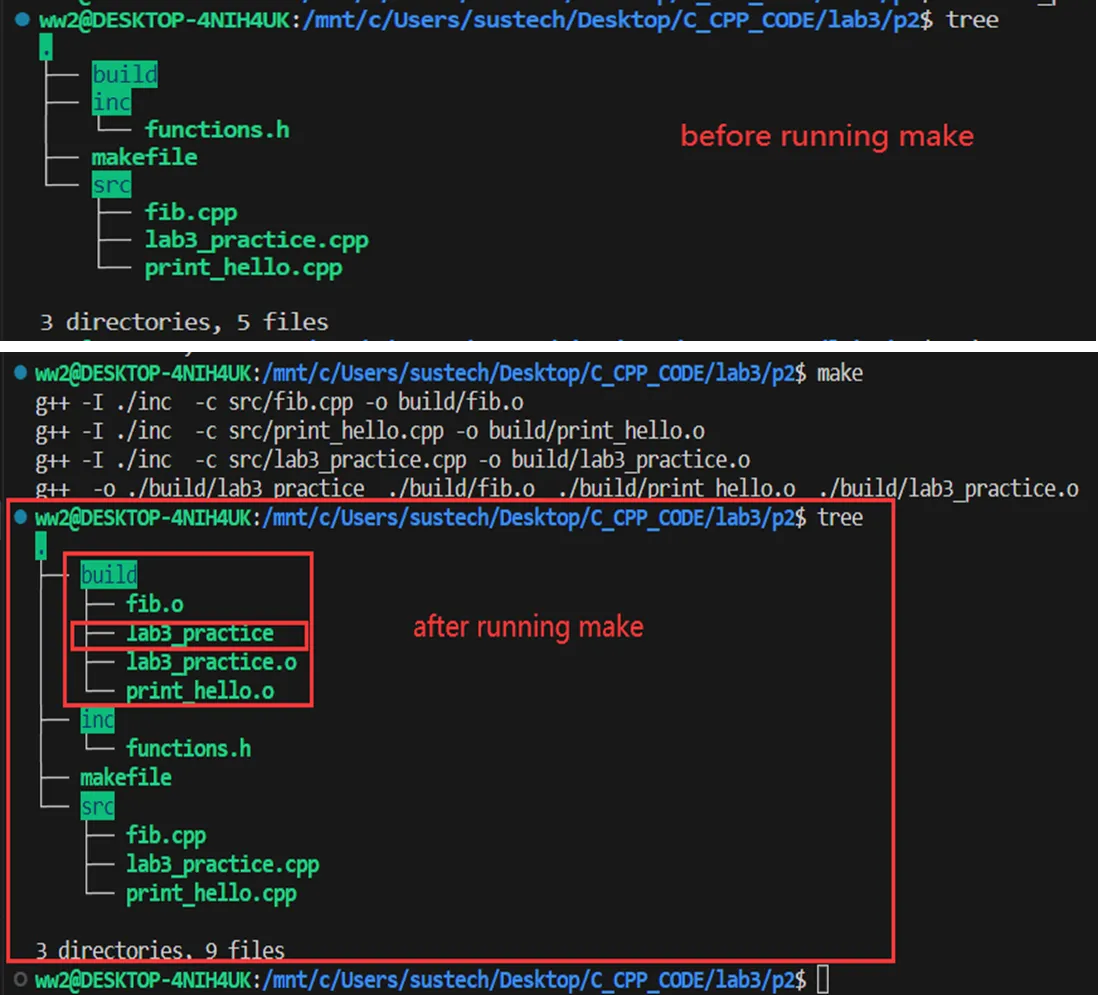
compile your project(program) or only compile the update files in the project by running
makebased on makefile to generate the executable filelab3_practice.NOTE
the object file *.o and the executable file
lab3_practiceshould be in the directorybuildTIP
根据这个目录去放置并且自行撰写Makefile文件
# 定义编译器 CC=g++ # 定义编译选项 CFLAGS=-Wall -g -IInc # 定义目标文件目录 BUILD_DIR=build # 定义源文件目录 SRC_DIR=src # 定义头文件目录 INC_DIR=Inc # 定义源文件 SRCS=$(wildcard $(SRC_DIR)/*.cpp) # 定义目标文件 OBJS=$(patsubst $(SRC_DIR)/%.cpp,$(BUILD_DIR)/%.o,$(SRCS)) # 定义最终的可执行文件 TARGET=$(BUILD_DIR)/lab3_practice # 创建目标文件目录 $(BUILD_DIR): mkdir -p $(BUILD_DIR) # 编译目标文件 $(BUILD_DIR)/%.o: $(SRC_DIR)/%.cpp | $(BUILD_DIR) $(CC) $(CFLAGS) -c $< -o $@ # 链接目标文件生成可执行文件 $(TARGET): $(OBJS) $(CC) $(OBJS) -o $@remove all the files in the directory
buildby runningmake clean# 清理生成的文件 clean: rm -rf $(BUILD_DIR)edit the source file
lab3_practice.cpp(change parameter5to another number), save it, then runmakeagain, which object file would be updated in the process?由于fib文件有错,修改factorial为fib,否则会没有定义fib而编译失败。
#include "functions.h" int fib(int n) { if (n <= 1) return n; return fib(n - 1) + fib(n - 2); }
4.3 Exercises . Run the following source code and explain the result.
You need to explain the reason to a SA to pass the test.
#include <iostream>
using namespace std;
int main()
{
for(size_t n = 2; n >= 0; n--)
cout << "n = " << n << " ";
return 0;
}
Using the size_t,and the size_t, and the range of the type like the unsigned int , so you will konw the n will not be less than 0.
4.4 Exerices . Run the following source code and explain the result.
You need to explain the reason to a SA to pass the test.
#include <iostream>
using namespace std;
int main()
{
int n = 5;
int sum;
while(n >0){
sum += n;
cout << "n = " << n << " ";
cout << "sum = " << sum << " ";
}
return 0;
}
Firstly,the code shows us a while-loop when n>0 its condition is true,but the sum donot initialize and n donot plus or mins to the while-loop is ALWAYS-TRUE.
#include <iostream>
using namespace std;
int main()
{
unsigned int n = 5;
int sum;
while(n >0){
sum += n;
cout << "n = " << (n-=2) <<endl;
cout << "sum = " << sum << " ";
}
return 0;
}
Secondly,the code shows the n is the unsigned int type ,but the sum still donot initialize.Then the n still not plus or mins to the while-loop is ALWAYS-TRUE .
Thirdly, there’re the same question in the two Codes,just like sum donot initialize and the n donot changes. So we should make the n mins,and initialize the sum.
4.5 Exerices. Run the following source code and explain the result.
#include <iostream>
using namespace std;
int main()
{
int n,fa;
do{
fa *= n;
n++;
}while(n <= 10);
cout << "fa = " << fa << endl;
return 0;
}
Actually, there’re the same problems in the Exerices4.4,donot initialize the participation elements of while-loop, it will effect on the while-loop cannot excute rightly.

